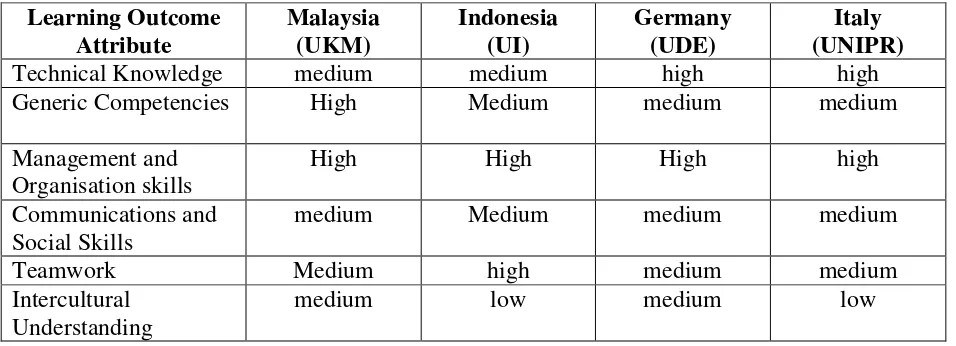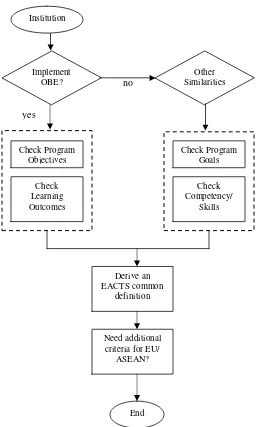Initiating Learning Outcome within EU-ASEAN Credit Transfer System Network Curriculum
M. Ismail1, A. Hunger2, C. Morandi4, R. F. Sari3, S.A. Russly1, I. Skalbergs2, A. Muchtar1, Nik Abdullah Mohamed1, R. Menozzi4
1
Universiti Kebangsaan Malaysia, Malaysia
2
University of Duisburg-Essen, Germany
3
University of Indonesia, Indonesia
4
Universy of Parma, Italy
Keyword: Outcome based education, learning outcomes, credit transfer system, student mobility
Abstract
In both EU and ASEAN a common trend towards the implementation of outcome based education (OBE) is on its way to enhance the quality of national higher education systems. Important benefit attributed to OBE is that it facilitates the transparent comparison of learning achievements and qualifications within a national system as well in an international context. In spite of the common trend, however, it has to be noted that the state of actual implementation of OBE varies substantially among different national systems. This poses, particularly, a problem in the context of international academic cooperation in which the mutual recognition of learning outcomes is crucial. This article focuses on the role of learning outcomes within a credit transfer system dedicated to the facilitation of student mobility between EU and ASEAN - the EU-ASEAN Credit Transfer System (EACTS). EACTS is being developed by a network of four partner institutions, the University of Duisburg-Essen, University of Indonesia, University of Parma and Universiti Kebangsaan Malaysia and is funded under the Asia-Link programme of the European Commission. The experience gained of developing learning outcomes or similar implementation in each partner institution will be highlighted and the common similarities of the descriptions and its accomplishment are identified. It also outlines how EACTS intends to deals with the different levels of implementation of learning outcomes among EACTS partner institutions. However, more focus will be given to OBE implementation in UKM.
Introduction
destination is by determining where it is and then plan backwards and strategise the best way to get from here to there.
The Western Australia Education Ministry define OBE as an educational process which is based on achieving certain specified outcomes in terms of individual student learning process. In OBE, basic questions such as “what do you want the students to learn?”, “why do you want them to learn it?”, “how can you best help students learn it?”, and “how will you know that they have indeed have learnt?” are addressed.
Outcome-Based Education is getting more and more popular as a teaching approach in universities for engineering education in all countries all around the world. Countries like the United States, Australia, South Africa and Hong Kong have long adopted the OBE in significant ways. OBE concept is more or less the same as Total Quality Management movements in the business sector. It is believed that by beginning with the end, determining where they are and then where they want to be, academic goals can be reached.
OBE is now fast replacing the traditional approach in engineering education and is gaining worldwide credence. The Washington Accord (WA), which is an agreement between the bodies responsible for accrediting professional engineering degree programmes in its signatory countries, requires that OBE be practiced in the programmes the signatory organisation (EAC, etc) accredits. In 1989, eight countries have signed this multinational agreement. These signatory countries were Australia, Canada, Hong Kong, Ireland, New Zealand, South Africa, United Kingdom and United States. This accord recognized the substantial equivalency of accreditation system of organizations holding signatory status, and the engineering education programs accredited by them. In other words, all graduates of engineering programs that have been accredited in a member country are considered already fulfilling the academic requirements to enter engineering practice in all countries signing the agreement.
In Malaysia, the education sector involving all fields of study are moving towards OBE. This initiative is driven by the Quality Assurance Department at the Ministry of Higher Education currently known as Malaysia Quality Agency (MQA). Engineering field is regard as the pioneer in embarking OBE in Malaysia. The Engineering Accreditation Council (EAC) under the preview of the Malaysian Board of Engineers are steering the way towards the OBE implementation in Malaysia. In 2001, Malaysia applied to be a provisional member of the WA and only by June 2003 Malaysia was accepted as a provisional member.
While in Europe, European Qualification Network (EQF) has been enforced in the context of higher education in Europe. The EQF will provide a commonly understood reference levels on how to describe learning in any system of qualification. The core element of the EQF is a set of eight reference levels describing what a learner knows, understands and is able to do (their 'learning outcomes) regardless of the system where a particular qualification was acquired.
This paper focuses on the experience of implementing learning outcomes or its similar implementation in each partner institution, but will focus most on UKM as UKM has most experience in implementing OBE in engineering education. It also propose a comparison method to initiating a common definition between the partner universities in enhancing a credit transfer system dedicated to the facilitation of student mobility between EU and ASEAN, namely the EACTS.
EACTS is being developed by partnership between four universities in Germany, Italy, Indonesia and Malaysia and is funded by the Asia-Link Program of the European Commission. The programme aims to promote the creation of new partnerships, to reinforce existing partnerships between European and Asian universities, and to create new sustainable links. The programme is funded by the EU budget, under the budget line for ‘Political, economic and cultural cooperation with Asian developing countries’. With the title “Contribution towards an EU-ASEAN Credit Transfer System leading to Implementation of Student Mobility and Joint-Award Degree Program in Engineering Education”, a desired condition of trans-regional student mobility is being developed between the partner universities. The project is currently in its pilot implementation stage and one of the EACTS activities is to focus on an Outcome Based Education Description in engineering programs of double degree or joint degree programs among the partnership.
Common Similarities and Achievements
For Indonesia, the reform of education from Knowledge Based Curriculum to Competence Based Curriculum is mainly due to the demands of the professional world. Using the CBC approach, graduates are enforced to fulfill the qualification not only on the theoretical knowledge but also the soft skills. Upon study completion, students need to accomplish certain competencies relevant to the course taken. In UI, Competence Based Curriculum is used as a teaching approach. Skills and knowledge need to be gained upon completion of course is listed out at the beginning stage. CBC has been adopted in Indonesia since 2004, being implemented in schools and higher education institute which has been enforced by the Ministry of National Education.
In the context of EQF, the descriptor for the bachelor degree qualification level corresponds to the learning outcomes for EQF level 6. In this level, student should have an advanced knowledge of theories and principles in the respected engineering field studied. Advance skills and competency showing a responsible engineer are to be illustrated.
Below table shows the result of an observation of learning outcomes attributes adopted in the engineering curricular of the partner countries. Only five main attributes has been observed. The “technical knowledge” is mainly the knowledge of underlying science and engineering fundamentals thought during the student study period. “Generic competencies” comprises of engineering ethics and self awareness on environmental issues in engineering practice. “Management and Organisation Skills”, “Communication and Social Skills” and “Teamwork” are soft skills adopted in the curricular. As for “Intercultural Understanding”, is more on the intercultural experience and internationalization of students.
Table 1: Learning Outcome Attributes adopted in the Engineering Curricular
Learning Outcome Attribute
Malaysia (UKM)
Indonesia (UI)
Germany (UDE)
Italy (UNIPR)
Technical Knowledge medium medium high high
Generic Competencies High Medium medium medium
Management and Organisation skills
High High High high
Communications and Social Skills
medium Medium medium medium
Teamwork Medium high medium medium
Intercultural Understanding
From the observation, the ASEAN universities show lower emphasis on technical knowledge rather than the European universities. However, UKM adopts more generic competencies in the curricular compared to the other universities. In Europe, the generic skills and competency of an ethical engineer may not be emphasized highly in the higher education level. However, these generic competencies have been adopted in the lower level of education.
In UKM eleven program outcomes and fifteen generic skills have been adopted in accordance with requirements from the Board of Engineers, Malaysia and the Malaysian Qualification Framework.
From a current survey carried out by lecturers from Engineering Faculty of UKM, on Student Perception of OBE Learning in an Engineering Course shows that high positive feedback were given on the understanding of the course importance and its objectives. However, a more neutral respond was obtained for ability to apply knowledge such as communication skills, in-depth technical competence in a related engineering field and problem solving skills that are learned during the course. Lastly, a high positive respond was obtained on the understanding of the responsibilities of an engineer and awareness of life long learning.
Comparison Method
The comparison method is a proposal on deriving a common definition of ‘outcomes’ between the partner universities of EACTS. In reference to different implementation approach of each partner institution, it is essential to come up with a mutual understanding of a definition so as to facilitate in the student mobility scheme that is being initiated.
Figure 1: Comparison Method Flow Diagram
Conclusion
The learning outcomes of EACTS partner have been observed. In general, we found out that ASEAN partner particularly Malaysia stretch more on generic skill in their learning outcomes where else the European Partner focus more on in depth technical content of curricular.
OBE promises high level of learning for all students as it facilitates the achievement of the outcomes, characterised by its appropriateness to each learner’s development level and active and experienced-based learning. Moreover, knowing that this system is going
Implement OBE?
Other Similarities
yes
no
Check Learning Outcomes Check Program
Objectives
Check Competency/
Skills Check Program
Goals
Derive an EACTS common
definition
Need additional criteria for EU/
ASEAN? Institution
to be used would also give students the freedom to study the content of the course in a way that helps them learn it. OBE must involve administrators, educators, parents, teachers and students for successful implementation. Finally, it is hoped that the effort in implementing the OBE will contribute to a Continuous Quality Improvement culture among the partnership of EACTS.
Reference
B. Budiardjo, N. A. Nik Abdullah, Axel Hunger, A. Muchtar, G.Passasseo, Ina Skalbergs, F. Astha Ekadiyanto, Enrico de Iaco, Engineering Education and Profession in EU and ASEAN, EACTS Project Report, September 2006.
Mohd Jailani Mohd Nor, Noraini Hamzah, Hassan Basri, Wan Hamidon Wan Badaruzzaman, Pembelajaran Berasaskan Hasil: Prinsip dan Cabaran, Proc. Seminar Pengajaran dan Pembelajaran Berkesan 2005, Fakulti Kejuruteraan, Universiti Kebnagsaan Malaysia, 2006.
Axel Hunger, A. Muchtar, F. Astha Ekadiyanto, Enrico de Iaco, Ina Skalbergs, Comparison of Engineering Disciplines, EACTS Project Report, February 2007.
Abdul Khalim Abdul Rashid, Azami Zaharim, Riza Atiq O. K. Rahmat, Students’ Perception Towards the OBE Learning Approach in an Engineering Course, Proc. Seminar Pengajaran dan Pembelajaran Berkesan 2005, Fakulti Kejuruteraan, Universiti Kebnagsaan Malaysia, 2006.
Syamsul Anuar A. H, Outcome-Based Education (OBE) in Malaysia, Anjung Visi Solution Sdn Bhd.
Widyawati, Menerapkan Kurikulum Berbasis Kompetensi tanpa Merombak Kurikulum Berbasis Isi, Pertemuan Ilmiah Tahunan IGI, Universitas Indonesia, 2006.
Chong, B.K. and Crowther, F. Apply Outcome-Based Framework to Measuring the Quality of Transnational Engineering Education, Proc. 36th ASEE/IEEE Frontiers in Education Conference, October 2006.
A.A. Aziz*, M.J. Megat Mohd Noor, A.A. Abang Ali and M.S. Jaafar, A Malaysian Outcome-Based Engineering Education Model, International Journal of Engineering and Technology, Vol. 2, No.1, 2005, pp. 14-21.
Kerry Kennedy, Curriculum Reforms and Instructional Improvement in Asia, T. Townsend (Ed.), International Handbook of School Effectiveness and Improvement, 807–822. © 2007 Springer

